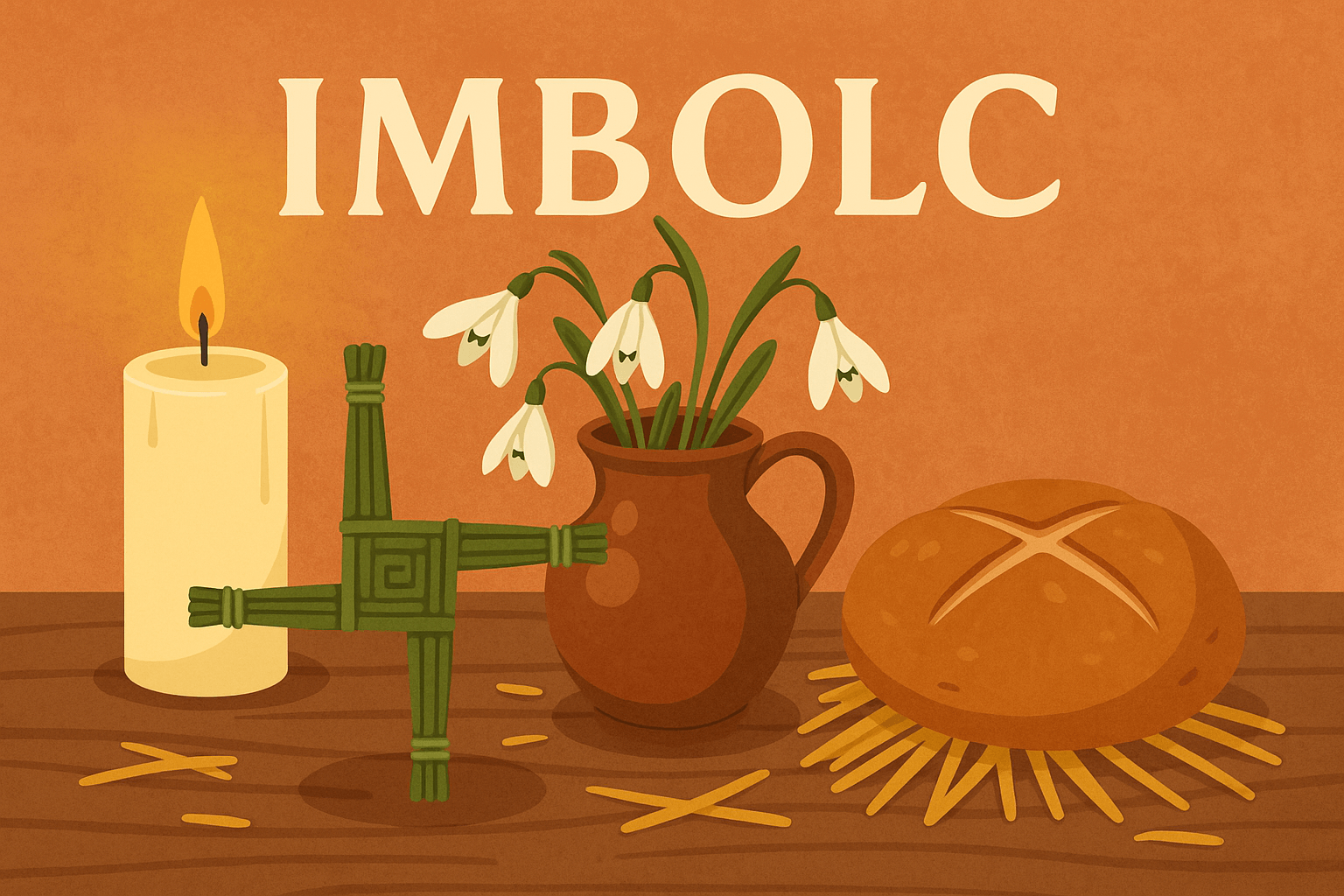What is Imbolc?
Imbolc (pronounced “Im-bulk” or sometimes “Im-olg”) is one of the four great Celtic fire festivals, celebrated halfway between the winter solstice and the spring equinox. This ancient festival marks the return of light, the first stirrings of spring, and the honoring of Brighid, the goddess of poetry, healing, and smithcraft.
For learners of the Irish language, exploring Imbolc traditions and blessings opens the door to both cultural and linguistic discovery. At Gaeilgeoir AI, we encourage students to explore festivals like Imbolc not just as history, but as living traditions where you can practice Irish words, greetings, and phrases.
Imbolc Meaning and Origins
The word Imbolc is thought to come from i mbolg, meaning “in the belly,” referencing the pregnancy of ewes and the promise of new life. This festival was deeply tied to cycles of nature, fertility, and renewal.
In Celtic mythology, Imbolc honored Brighid, later adopted into Irish Christian tradition as Saint Brigid, whose feast day falls on February 1st. Many Imbolc rituals and blessings survived by blending pagan and Christian practices, making the festival one of Ireland’s most enduring cultural celebrations.
If you’d like a broader overview of how Imbolc fits into the Gaelic calendar, you can explore our Gaelic Calendar Guide.
Symbols of Imbolc
Several symbols are strongly associated with the season:
- Brigid’s Cross – Woven from rushes, symbolizing protection and renewal.
- Candles and Fires – Representing returning sunlight and purification.
- White and Green Colors – Purity, fertility, and the earth’s awakening.
- Milk and Seeds – Foods tied to fertility and nourishment.
These symbols of Imbolc are not just decorative but also carry layers of meaning that connect language learners to cultural storytelling.
Imbolc Traditions and Customs
Traditional Imbolc customs highlight themes of renewal, fertility, and blessing. Some of the most common include:
- Lighting Candles and Fires – To welcome back the sun and banish winter darkness.
- Crafting Brigid’s Crosses – Hung in homes for protection throughout the year.
- Household Blessings – Sprinkling water or sweeping hearths to invite good fortune.
- Visiting Holy Wells – Offering prayers and tying cloths (clooties) to sacred trees.
- Seasonal Feasts – Enjoying dairy-based dishes and fresh breads.
These Imbolc traditions continue to be celebrated in Ireland and among Celtic communities worldwide.
Imbolc Rituals: Then and Now
Ancient Rituals
- Farmers performed fertility rites to ensure healthy crops and livestock.
- Priests and druids lit sacred fires in Brighid’s honor.
- Offerings of milk, butter, or bread were left outside for the goddess.
Modern Rituals
- Lighting a candle at sunset on February 1st.
- Creating personal altars with Imbolc decorations like white flowers and seeds.
- Writing intentions for growth and renewal in the coming year.
Many learners enjoy pairing their language study with small seasonal Imbolc rituals, making vocabulary more memorable through lived practice.
Foods for Imbolc: Seasonal Recipes
Food played an important role in the Imbolc feast, symbolizing abundance and fertility. Traditional foods for Imbolc included:
- Dairy products: Milk, butter, cheese – reflecting lambing season.
- Oatcakes and Bannocks: Simple breads baked on hearth fires.
- Seeds and Grains: Symbolizing the planting season.
- Leeks, onions, and root vegetables: Winter staples.
Popular Imbolc Recipes Today
- Colcannon – Mashed potatoes with cabbage or kale.
- Barmbrack – A sweet bread with dried fruit.
- Herbal teas – Especially chamomile or mint for cleansing.
Cooking traditional dishes is one of the easiest ways to celebrate Imbolc while learning new Irish food vocabulary.
How to Celebrate Imbolc Today
Whether you’re in Ireland or abroad, you can embrace Imbolc celebrations with simple practices:
- Light candles or a fire to welcome back the sun.
- Cook a traditional Imbolc recipe with friends or family.
- Make a Brigid’s Cross and hang it above your doorway.
- Write down intentions for the coming months.
- Practice Irish by learning Imbolc blessings and greetings.
These actions not only connect you with Irish culture but also make your language learning journey more immersive.
Blessed Imbolc: Greetings and Blessings
If you’d like to wish someone well during this season, here are a few phrases:
- “Beannachtaí na Féile Bríde ort” – Blessings of St. Brigid’s Day upon you.
- “Imbolc sona duit” – Happy Imbolc to you.
- “Beannachtaí Imbolc” – Imbolc blessings.
If you’re curious about how greetings work in everyday Irish, check out our guide: A Chara – Irish Greeting.
Brighid and Imbolc
At the heart of Imbolc rituals is Brighid, a Celtic goddess associated with:
- Poetry and Learning – Inspiration for bards.
- Healing and Fertility – Protecting women, children, and livestock.
- Smithcraft and Fire – Creative transformation.
Later venerated as Saint Brigid of Kildare, she remains one of Ireland’s most beloved figures. Her festival blends pagan Imbolc customs with Christian celebrations, making her central to both folklore and faith.
Imbolc Blessings in Irish
Using Irish phrases during seasonal celebrations is a wonderful way to integrate language and culture. Examples include:
- “Go mbeannaí Bríd thú” – May Brigid bless you.
- “Beannachtaí na Samhna agus na hImbolc ort” – Blessings of Samhain and Imbolc upon you.
For learners, phrases like these bring warmth and authenticity to the holiday.
Why Learn About Imbolc While Learning Irish?
Festivals like Imbolc provide:
- Rich Vocabulary – Words for rituals, foods, and traditions.
- Cultural Insight – Understanding Irish heritage beyond textbooks.
- Practical Application – Seasonal greetings to use with fellow learners.
At Gaeilgeoir AI, our tools help you explore topics like Imbolc in interactive ways. By connecting seasonal festivals with your studies, you create stronger memory links and more meaningful learning.
Related Festivals: The Celtic Year
Imbolc is part of a cycle of Celtic fire festivals, including:
- Bealtaine – Celebrated in May, marking fertility and summer’s arrival.
- Lughnasa – The harvest festival in August.
- Samhain – The Celtic New Year in late October.
You can read more about Bealtaine to see how these seasonal traditions connect.
Conclusion: A Season of Renewal
Imbolc is more than a date on the calendar – it is a reminder of renewal, light, and community. Whether you light a candle, bake bread, or weave a Brigid’s Cross, you are connecting with a tradition that stretches back thousands of years.
For learners of Irish, exploring Imbolc meaning, blessings, and rituals provides not just vocabulary, but a living connection to the culture.
Ready to bring Irish traditions into your language learning journey? Join our community and try Gaeilgeoir AI today: Sign up for free.


